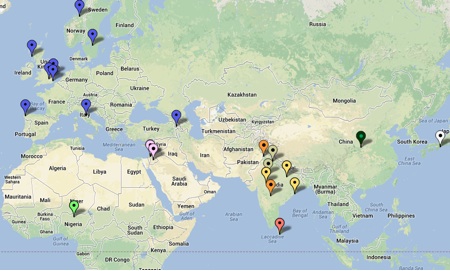|
|
|
|
|

|
|
|
GPN Frequently Asked Questions FAQ
This page has not been updated since June 2014.
Here are some of the frequently asked questions about
the Green Pilgrimage Network. Click on any of them to
see the answers.
What is the Green Pilgrimage Network
When was it started?
Who are the members?
What do you need to do to join the GPN?
What does the vision statement intend to achieve?
Where is there information about this?
What kind of meetings do you have?
Are there regional chapters?
How is it funded?
Can the GPN fund environmental projects in my city/
pilgrimage place?
Where do I find out more?
What kind of successes has the Network had so far?
What do the new members of GPN plan to do?
How do I sign up for the newsletter?
1986: Beginnings at Assisi
What is the Green Pilgrimage Network (GPN?)
The GPN is a global network of pilgrim cities and sacred
sites around the world wanting to be models of green
action and care. Members of the GPN share a vision of
pilgrims on all continents, and the pilgrim cities that
receive them, becoming models of care for the
environment and leaving a positive footprint on the
earth.
It emerged from asking the questions: “Why are the
world’s holiest places not the world’s cleanest and
most cared for places? And can the fact that they are
holy, or sacred, be used by people who live there and
worship there, to make them greener?”
return to the top of the page
When was it started?
The Network was launched in Assisi, Italy in November
2011. The idea emerged from a major meeting of faiths
and environmentalists at Windsor Castle in November
2009, hosted by the Alliance of Religions and
Conservation (ARC) and HRH Prince Philip, ARC’s founder.
The event was supported by the United Nations and
attended by UN Secretary-General HE Ban Ki-moon.
return to the top of the page

|

|

|
Map showing location of GPN member sites as
of July 2013 (except Mexico City)
|
Who are the members?

|

|

|
Map showing location of Mexico City
|
Originally there were 12 founding members from 10
different faith traditions:
1. Amritsar, India for Sikhs
2. Assisi, Italy for
Catholics
3. Etchmiadzin, Armenia for Armenian
Orthodox Christians
4. Haifa, Israel for
Baha’is
5. Kano, Nigeria for Islam’s Qadiriyyah
Movement
6. Louguan, China for Daoists
7. St
Albans, UK for Anglicans
8. Trondheim, Norway for
the Lutheran Church
9. Jerusalem municipality for
Jewish, Christians and Muslim pilgrims to the city
10.
Luss, for the Church of Scotland
11. St Pishoy
Monastery in Egypt for the Coptic Orthodox Church
12.
Jinja Honcho, the Association of Shinto Shrines in
Japan
In Trondheim, Norway at the second GPN
meeting in July 2013, another 16 members joined. They
are:
1. The City of Nanded and Takhat Sri Hazur Sahib,
India (Sikh)
2. The City of Puri and the Sri
Jagannath Temple, India (Hindu)
3. Rajaji
National Park, Uttarakhand, India (place of Hindu
pilgrimage)
4. Ranthambore Tiger Reserve,
Rajasthan, India (place of Hindu pilgrimage)
5.
The City of Rishikesh and Parmarth Niketan Ashram,
India (Hindu)
6. The City of Ujjain, India
(Hindu)
7. The City of Varanasi, India (Hindu)
8. Mexico City Government (Catholic)
9.
The City of Bethlehem (Christian)
10. Friends of
the Earth Middle East and the Lower Jordan River
Rehabilitation Project (sacred to Christians, Jews and
Muslims)
11. The Municipality of Santiago de
Compostela (Christian)
12. The Municipal Council
of Matale, Sri Lanke (Buddhist)
13. The Pilgrim
Centre in Vadstena, Vadstena Dals Parish and the
Linkoping Diocese of the Church of Sweden. (Christian)
14. The Diocese of Canterbury, Church of
England. (Christian)
15. Norwich Cathedral, The
Church of England. (Christian)
16. The Iona
Community, Scotland (Christian)
return to the top of the page
What do you need to do to join the GPN?
To join the GPN you must be representative of either a
municipality or a faith group significant to a
pilgrimage place.
You must, with your tradition or
organization or municipality supporting you, sign up to
the GPN vision statement….
The Green Pilgrimage Network Vision Statement
The vision of the Green Pilgrimage Network is of
pilgrims, and the pilgrim cities and places that
receive them, becoming models of care for the
environment and leaving a positive footprint on this
earth.
We, the members of the Green
Pilgrimage Network support this vision, and commit to
create an action plan to transform our pilgrim city,
place or route into a green, sustainable model in
keeping with the beliefs of our faith or the faiths of
our pilgrimage place.
This action plan
will be the roadmap for improving the environmental
impacts of the city or place and pilgrimage routes. We
will share this action plan with other members of the
Green Pilgrimage Network.
Each of us also
commits to bring faith and secular groups together to
work in partnership towards this vision.
We pledge to promote this in the local
media, and we will work with visiting pilgrims to make
their journeys as environmentally friendly as
possible. We will do this through greening our
transport, accommodation, food, water supply, waste,
sanitation and wild places, as well as encouraging
green parks, environmental education and wildlife
protection for and by local residents.
We
also pledge to support and help each other, and to
promote green pilgrimage ideas where we can.
And then of course, you must follow it
through, and report back about your progress – both your
successes and your failures so others can learn and be
inspired.
return to the top of the page
What does the vision statement intend to achieve?
It gives the opportunity for religious and secular
authorities in a pilgrimage place, route or city to
commit themselves to work together to draw up an action
plan. The intention for this is to introduce good
environmental practice to transform their pilgrimage
place into a green, sustainable model and to share this
and progress made with the GPN network.
return to the top of the page
Where is there information about this?
The ARC website had a
GPN page . We hope to have more information from partner
organisations soon.
We also have a very
comprehensive handbook, giving ideas about how you can
make your pilgrimage place greener (and examples from
others, who already have). You can download the handbook
from
here. As well as the original version it is also available
in a version adapted for Hindu sites in India and
another for Catholic sites, created for the World Youth
Day celebrations in Rio de Janeiro, 2013.
return to the top of the page
What kind of meetings do you have?
Our inaugural meeting was in Assisi in Italy in November
2011, followed by a meeting in July 2013 in Trondheim in
Norway, hosted by ARC, the National Pilgrim Centre, the
municipality of Trondheim and the Diocese of Nidaros.
In 2014 Jinja Honcho in Japan hosted a GPN
meeting in Ise, Japan to mark the rebuilding of the
Grand Shrines of Ise.
return to the top of the page
Are there regional chapters?
In Hyderabad, India in October 2012, several cities
expressed interest in an Indian Chapter of the Green
Pilgrimage Network. In November 2012, a meeting in
Rishikesh in India initiated the formation of a Hindu
group of pilgrim cities which will be part of the India
Chapter.
return to the top of the page
How is it funded?
Funding for specific projects in the Network came to ARC
from the Ministry of Foreign Affairs of the Norwegian
Government. That funding has now reached the end of its
term.
ARC provided some small seed funding to
selected projects in the Network for 2013-2014.
Cities and pilgrimage places that join the
Network are responsible for drawing up their own action
plans and funding their own programmes. However some
have found that being part of the network, and using
this constructive, planned approach to environmental
action, can often attract local funding from faiths or
municipalities.
Cities hosting meetings,
such as Trondheim in Norway, are largely responsible for
bearing the costs of each meeting.
return to the top of the page
Can the GPN fund environmental projects in my city/
pilgrimage place?
Unfortunately not. Sometimes we can link you with groups
that might provide advice on funding, such as the local
government organization, ICLEI, who are working with
Indian pilgrimage cities in this way. ICLEI brings
expertise, for example, on green waste or sanitation or
solar power. ICLEI is now carrying out assessments of
six pilgrim cities in India looking at their
environmental needs and how they might be met in
partnership.
Sometimes, advice on funding can come
through sharing what you are doing with other members
who have accessed funding for similar work.
Sometimes new initiatives or ideas for
spreading green pilgrimage practice requires little or
no funding but rather a change in behaviour, practice or
mindset.
return to the top of the page
Where do I find out more?
You can see past issues of the newsletter
here. We hope to have links from Green Pilgrimage chapters
soon.
return to the top of the page
What kind of successes has the Network had so far?
Since its initiation in 2011 the GPN saw many inspiring
and innovative developments throughout the original
member pilgrimage sites. For examples of these
achievements click
here.
return to the top of the page
What do the new members of GPN plan to do?
For information about the new members and their initial
plans click the following links:
Nanded
Puri
Rajaji National Park & Ranthambore Tiger Reserve
Rishikesh
Ujjain
Varanasi
Mexico City
Bethlehem
River Jordan - Friends of the Earth Middle East
Santiago de Compostela
Matale
Vadstena Pilgrimage Centre
Canterbury Cathedral
Norwich Cathedral
The Iona Community
return to the top of the page
|

|
|
|
|
|
|
|

